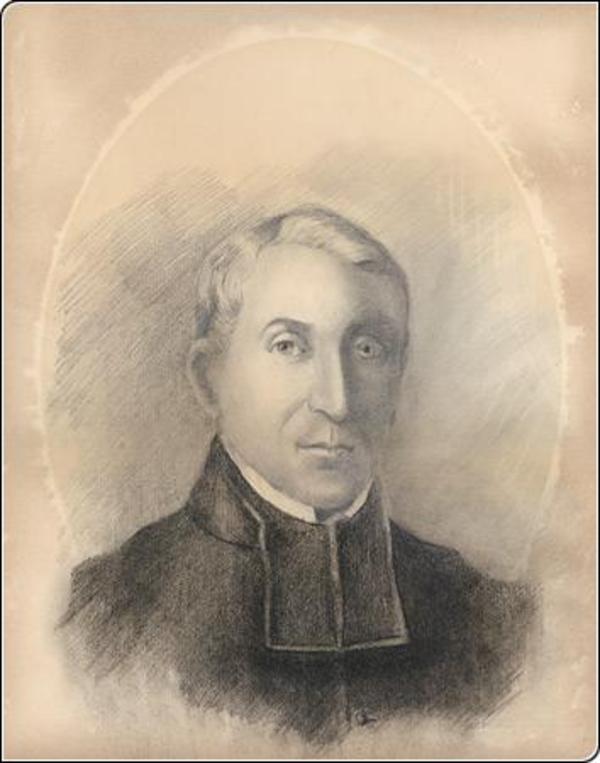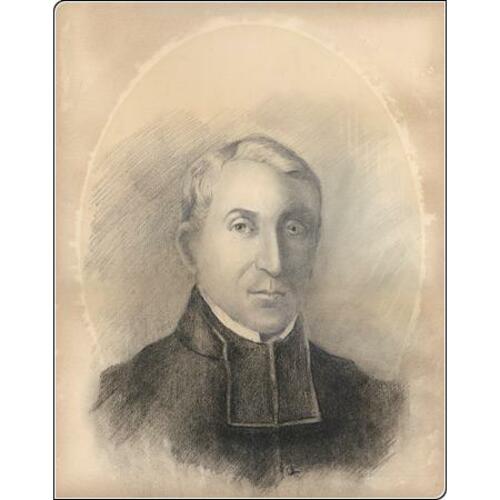
Source: Link
DUMOULIN, SÉVÈRE (baptized Sévère-Joseph-Nicolas), Roman Catholic priest, missionary, and author; b. 5 Dec. 1793 in Sainte-Anne-de-Bout-de-Île (Sainte-Anne-de-Bellevue), Lower Canada, son of François Dumoulin and Louise Cressé; d. 27 July 1853 in Trois-Rivières, Lower Canada.
Sévère Dumoulin’s father was Swiss and Protestant by origin, but he married as a Roman Catholic when he took a daughter of Louis-Pierre Poulin* de Courval Cressé to be his wife. She had already inherited a third of the Courval seigneury after her father’s death in 1764, and became its sole owner in 1796 when her brother Pierre-Michel Cressé* assigned his share to her. The Dumoulins took up residence among their censitaires, and later moved to Nicolet where three of their sons would attend the seminary; Sévère completed his classical and theological studies between 1807 and 1816, Pierre-Benjamin attended from 1810 to 1815, and Jean-Emmanuel was a pupil from 1810.
Sévère Dumoulin was ordained priest on 23 Feb. 1817 and appointed curate of Notre-Dame cathedral at Quebec. In 1818 Bishop Joseph-Octave Plessis* sent him and Abbé Joseph-Norbert Provencher to set up a mission in the Red River colony (Man.). Although the missionaries were eagerly awaited by Lord Selkirk [Douglas*] and the settlement’s Catholic population, they had been instructed to make Christianizing the Indians “the primary object” of their labours.
Dumoulin left Quebec on 24 April 1818, and after a few days visiting his family reached Montreal on 8 May. There he was delayed by organizational difficulties and still more by latent, unresolved quarrels between the Hudson’s Bay Company, in which Lord Selkirk was a shareholder, and the North West Company. The “apostolic canoe” carrying the three ecclesiastics – seminarist William Edge accompanied the two priests – left Montreal on 19 May and reached Red River on 16 July. A naturally resourceful man with no “excess of fat,” Dumoulin easily endured the discomforts and fatigues of the long journey. He had also made his first contact with the Indians, and had already formed the conviction – from which he never really deviated – that their conversion would be easier “if one could manage to gather them into villages.” This view ran counter to that of Provencher and Plessis, who believed that a missionary should adapt to the Indians’ way of life and if necessary travel with them to preach the Gospel.
Although Dumoulin started his work by ministering to the colony’s whites and Métis, he also began studying Indian languages. On 13 Sept. 1818 he went with Edge to Pembina (N.Dak.), which he made his principal place of residence. There he encountered a large population of Indians, Métis, and whites, attracted by the herds of buffalo near by. Despite some unforeseen obstacles – two attempted murders by a disgruntled Indian, the arrival in 1820 of a Protestant minister, John West*, and the lack of “presents” – he managed to create a lively Christian community. On his arrival Dumoulin opened a school with Edge as teacher; it soon had about 60 pupils. Not long afterwards he sent a young French Canadian, one Legacé, to teach the children in the buffalo-hunting camps at some distance from the village. Provencher informed Plessis in a letter written in February 1819 that Legacé, who was spending the winter on the plains, had even more pupils than Edge. Dumoulin helped establish Pembina as a settled and permanent community by building a presbytery, a school, and a chapel which was opened in 1821.
In the summer of 1819 Dumoulin had gone on a three-month evangelizing journey which took him to Rainy Lake (Ont.), and the following summer he set off again for seven weeks, this time reaching Hudson Bay. These trips produced little result; like his visits to the parish of Saint-Boniface created by Provencher at Red River, they were only interruptions to his work in the Pembina mission. There, up to June 1821, Dumoulin recorded 326 baptisms, 56 marriages, and 31 burials, and was delighted to be able to note: “I have succeeded this year in getting a good many Indians to plant crops [and they] have formed small villages.” But even by 1818 the future of Dumoulin’s mission had been compromised: a treaty signed that year settling the frontier between American and British territory to the west of Lake Superior had placed Pembina in the United States. With Selkirk’s death in 1820 and the instructions given by John Halkett, the administrator of his estate, to abandon Pembina and bring its people back to Red River, Provencher was forced to recall Dumoulin in 1823. Unhappy with this decision, Dumoulin sought permission to return to Lower Canada and, despite the disappointment of Provencher and Plessis, he left the northwest in 1823 to the regret of his converts.
On returning to Lower Canada, Dumoulin was given the parish of Saint-François-de-Sales (at Saint-François-de-Montmagny), but he retained his interest in the missions he had left. In 1824 he published Notice sur les missions de la Rivière-Rouge et du Sault Ste-Marie; in it he supported Provencher’s appointment as bishop of Juliopolis and coadjutor to Plessis for the northwest, and answered the criticisms of some of the Lower Canadian clergy. At the same time he set up a fund for the missions which brought in more than £600. He put his missionary experience at the service of Bishop Joseph Signay* in 1837–38 and 1840, agreeing to work among the Têtes de Boules at Weymontachingue, on the upper reaches of the Saint-Maurice River.
Dumoulin in October 1825 became the ninth parish priest of Sainte-Anne at Yamachiche, where he remained until he died. His administration was marked by various developments: the division of the parish, which had become over-populated, and the creation of two new parishes, Saint-Barnabé in 1835 and Saint-Sévère in 1850; the impetus he gave to parish institutions in rebuilding the church and presbytery; the founding of a convent under the Congregation of Notre-Dame in 1852 and of a boys’ school entrusted to the Christian Brothers in 1853 and, finally, a renewed devotion to the parish’s patron saint, St Anne.
During the summer of 1853 Sévère Dumoulin felt ill. He left the parish to stay with his brother Pierre-Benjamin, a lawyer at Trois-Rivières, and to place himself under the care of a local doctor. He died there on 27 July at the age of 59. One account noted that “his funeral service was the most solemn ever sung in the church at Yamachiche,” and for a long time his parishioners continued to venerate Dumoulin as a saint and to attribute to him certain signal favours they received.
The correspondence of Sévère Dumoulin is found, for the most part, in AAQ, 330 CN, I–II, and in Arch. de l’évêché de Trois-Rivières (Trois-Rivières, Qué.), Paroisses, Sainte-Anne (Yamachiche). His letters from the Red River Colony have been edited by G. L. Nute and most were published in Documents relating to northwest missions, 1815–1827 (St Paul, Minn., 1942). Copies of the majority of the letters sent to Dumoulin are in AAQ, 210 A, IX–XXI.
His pamphlet, Notice sur les missions de la Rivière-Rouge et du Sault Ste-Marie (Saint-Pierre-de-la-Rivière-du-Sud, Qué., 1824), has been reprinted under the title Notice sur la Rivière-Rouge dans le territoire de la baie d’Hudson (Montréal, 1843). The manuscript text of the Notice, entitled “Exposé naïf sur la mission de la Rivière-Rouge suivi d’une souscription” and dated 19 Feb. 1824, is available in ASN, AP-G, L.-É. Bois, D, 14, no.67.
J.-E. Bellemare, Histoire de Nicolet, 1669–1924 (Arthabaska, Qué., 1924). Napoléon Caron, Histoire de la paroisse d’Yamachiche (précis historique) (Trois-Rivières, 1892). J.-É. Champagne, Les missions catholiques dans l’Ouest canadien (1818–1875) (Ottawa, 1949). Georges Dugas, Monseigneur Provencher et les missions de la Rivière-Rouge (Montréal, 1889). Marcel Giraud, Le Métis canadien; son rôle dans l’histoire des provinces de l’Ouest (Paris, 1945). A.-G. Morice, Histoire de l’Église catholique dans l’Ouest canadien, du lac Supérieur au Pacifique (1659–1905) (3v., Winnipeg et Montréal, 1912). J.-A. Pellerin, Yamachiche et son histoire, 1672–1978 ([Trois-Rivières], 1980). Antoine d’Eschambault, “La Compagnie de la baie d’Hudson et l’effort missionnaire,” SCHÉC Rapport, 12 (1944–45): 83–99. Albert Tessier, “Un curé missionnaire: l’abbé S.-N. Dumoulin (1793–1853),” Cahiers des Dix, 16 (1951): 117–31.
Cite This Article
Nive Voisine, “DUMOULIN, SÉVÈRE (baptized Sévère-Joseph-Nicolas) (1793-1853),” in Dictionary of Canadian Biography, vol. 8, University of Toronto/Université Laval, 2003–, accessed December 31, 2025, https://www.biographi.ca/en/bio/dumoulin_severe_1793_1853_8E.html.
The citation above shows the format for footnotes and endnotes according to the Chicago manual of style (16th edition). Information to be used in other citation formats:
| Permalink: | https://www.biographi.ca/en/bio/dumoulin_severe_1793_1853_8E.html |
| Author of Article: | Nive Voisine |
| Title of Article: | DUMOULIN, SÉVÈRE (baptized Sévère-Joseph-Nicolas) (1793-1853) |
| Publication Name: | Dictionary of Canadian Biography, vol. 8 |
| Publisher: | University of Toronto/Université Laval |
| Year of publication: | 1985 |
| Year of revision: | 1985 |
| Access Date: | December 31, 2025 |



